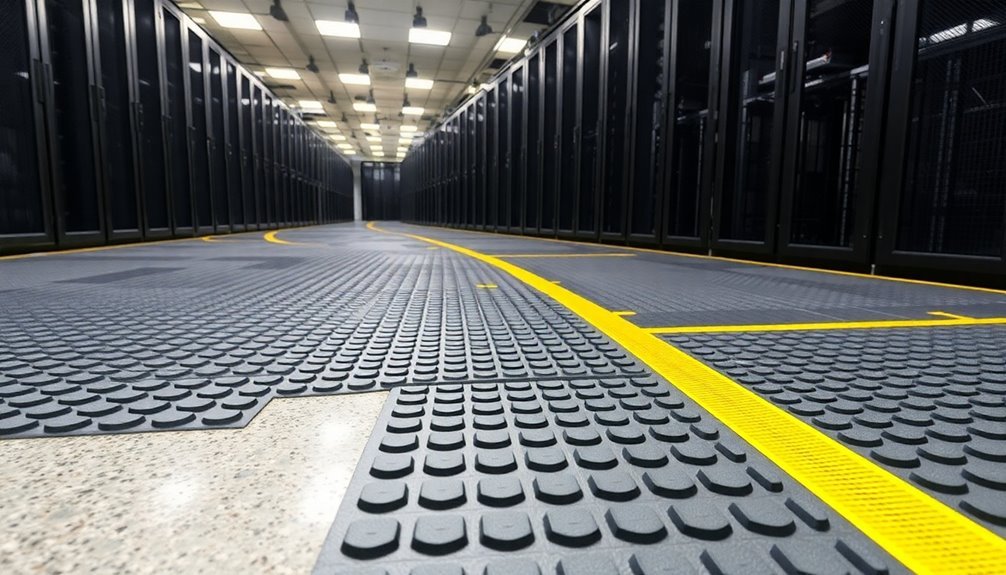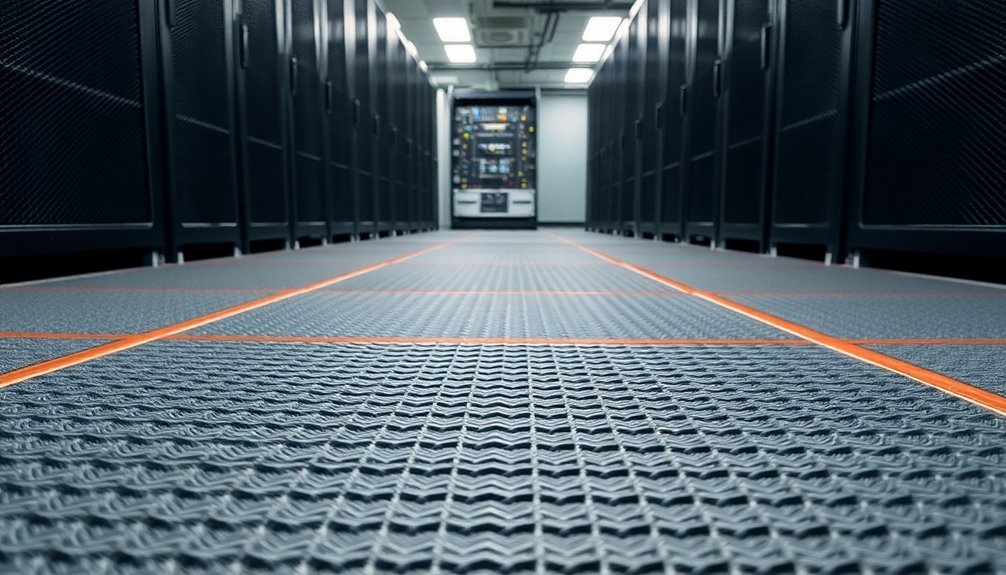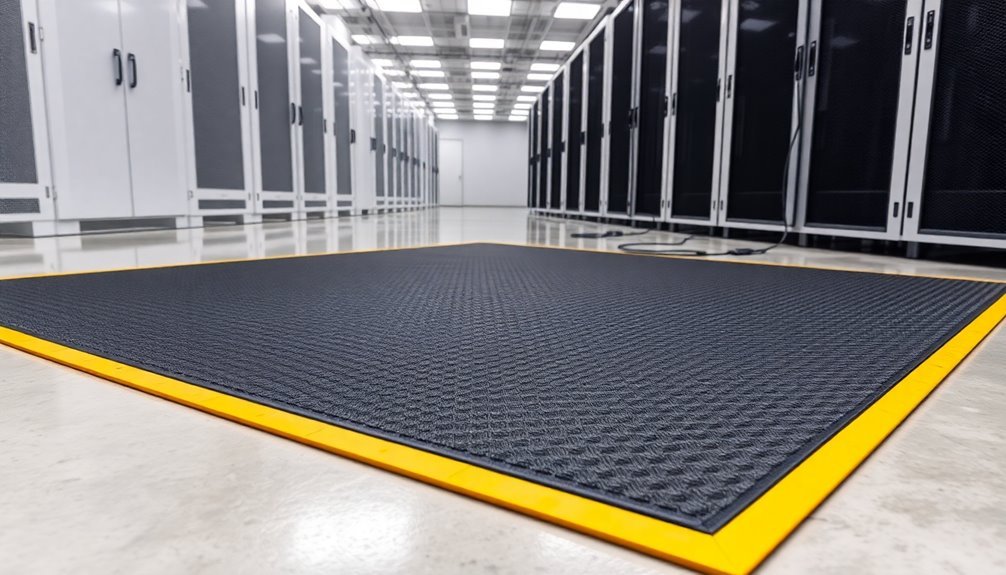ESD floor mats are your critical first line of defense against static discharge in server rooms. You'll need these specialized mats to prevent static buildup that can damage sensitive electronics with as little as 20 volts. They work by incorporating conductive materials like carbon or graphite to safely channel static electricity to ground. When selecting your mats, consider rubber options for superior durability and guarantee they meet resistance requirements between 1 x 10^6 and 1 x 10^9 ohms. Proper installation with grounding systems and regular maintenance with ESD-safe cleaners will maximize protection. Understanding the complete system of static control can make the difference between protected and vulnerable equipment.
Understanding ESD Floor Protection Basics

Three fundamental aspects make ESD floor protection essential for server rooms: its ability to prevent static discharge, its conductive properties, and its precise installation requirements.
You'll find that even a minimal static discharge of 20 volts can damage or destroy sensitive microelectronics in your server equipment, making proper protection vital for your facility's operation.
The way ESD floor protection works is through specialized materials containing conductive elements like carbon, graphite, or metal-coated particles. These materials create a controlled pathway that safely channels static electricity to the ground, preventing it from accumulating on your valuable electronic equipment. Specialized cleaning products must be used during maintenance to maintain the floor's conductivity.
When you walk across an ESD floor, any static generated flows through this pathway rather than building up and potentially causing damage.
Your ESD flooring system connects to either an electrical outlet or earth ground through a conductive underlayment, typically made of copper foils or carbon-loaded adhesive. This complete circuit guarantees consistent protection throughout your server room.
When selecting ESD floor protection, you'll need to evaluate whether your staff uses ESD footwear, as this affects the type of flooring you'll require – either conductive or dissipative.
Key Performance Testing Requirements
Testing requirements form the backbone of ESD floor mat certification and performance validation in server rooms. You'll need to verify your mats meet specific resistance measurements, including surface resistance of ≥ 1 x 10^6 ohms and resistance to groundable point between 1 x 10^6 and 1 x 10^9 ohms. Performing surface resistance measurements provides data for evaluating the effectiveness of your ESD protection system.
| Test Type | Requirement | Standard |
|---|---|---|
| Body Voltage | <100 volts peak | ANSI/ESD STM97.2 |
| System Resistance | <1.0 x 10^9 ohms | ANSI/ESD STM97.1 |
| Surface Resistance | ≥1 x 10^6 ohms | ANSI/ESD S4.1 |
You'll want to follow key testing methods like ANSI/ESD STM7.1 for measuring electrical resistance and ANSI/ESD STM97.1 for evaluating system resistance with static control footwear. Don't forget to conduct periodic testing under low humidity conditions (below 20%) to verify continued performance. Your floor mats must comply with industry standards such as Motorola R56 and ANSI/ESD S20.20, which set specific requirements for resistance measurements and charge generation. When evaluating ESD floor mats, focus on electrical resistance ranges, charge generation capabilities, and compatibility with your server room's operational conditions.
Selection and Material Considerations

Successful implementation of ESD floor mats in server rooms begins with careful material selection and understanding key considerations. You'll need to choose between rubber and vinyl materials, with rubber offering superior durability and resistance to chemicals and heat. While vinyl mats are less expensive, they won't withstand the heavy traffic and equipment movement typical in server rooms. Static damage prevention requires proper grounding of mats via grounding cords.
Consider the layered composition of your floor mat options. Two or three-layer mats provide better static control through their conductive and dissipative layers.
You'll want to confirm your selected mat meets ANSI ESD-S20.20 requirements and maintains electrical resistance below 10^9 ohms for effective static dissipation.
Your installation method matters too. Floor runners might work best for covering large areas, while interlocking tiles offer flexibility for reconfiguration. Remember that non-monolithic surfaces can create potential failure points, so you'll need to weigh this against your specific needs.
Don't forget to factor in your operational environment – humidity levels and staff footwear requirements will impact your mat's performance. While higher-quality mats cost more initially, they typically deliver better static control and longer service life.
Professional Installation Best Practices
Professional installation marks the critical difference between an effective ESD floor mat system and one that may fail prematurely. Before installation begins, you'll need to thoroughly prepare your server room's subfloor by removing debris, testing for moisture, and addressing any structural issues that could compromise the system's integrity. Maintaining proper environmental conditions is essential, with temperature and humidity needing careful monitoring throughout the installation process.
| Installation Step | Key Requirements |
|---|---|
| Subfloor Prep | Clean thoroughly, repair cracks, test moisture levels |
| Acclimation | Allow materials to adjust to room temperature for 24-48 hours |
| Adhesive Application | Use specified conductive adhesives, verify even coverage |
| Grounding System | Install copper strips, verify continuous conductivity |
You'll want to follow manufacturer guidelines precisely while installing your ESD floor mats. This includes using the correct conductive adhesives and maintaining proper alignment between tiles. Don't skip the essential step of installing vapor barriers if moisture testing indicates their necessity. After installation, conduct thorough testing to verify the system's effectiveness, and document all procedures for warranty purposes. Remember to train your staff on proper maintenance protocols to extend the life of your ESD flooring system. Regular inspections will help you identify and address potential issues before they impact your server room's protection.
Standards and Compliance Guidelines

Maintaining compliance with ESD flooring standards guarantees your server room meets critical safety and performance requirements. You'll need to verify your ESD floor mats meet ANSI/ESD S20.20 specifications, which require less than 20 volts of electrostatic current generation and specific resistance measurements.
Your floor mats must maintain resistance to ground between 1.0 x 10^6 and 1.0 x 10^9 ohms, with point-to-point measurements not exceeding 1.0 x 10^9 ohms. You should test these values using ANSI/ESD STM7.1 procedures.
Regular compliance verification testing must be documented to ensure continued effectiveness of your ESD control measures. When measuring between any two points 1m apart, your flooring system shouldn't provide less than 150 kilohms of resistance.
You'll also need to evaluate industry-specific requirements. If you're working with dispatch centers or equipment rooms, follow Motorola R56 guidelines, which align with the general resistance requirements.
Don't forget to maintain relative humidity between 35% and 60% to help control static electricity.
When installing floor mats in raised floor environments, you must verify proper grounding to the building's steel structure at multiple points.
Remember that your chosen ESD flooring solution should perform effectively regardless of footwear types or environmental conditions.
Frequently Asked Questions
How Often Should ESD Floor Mats Be Replaced in a Server Room?
You'll need to replace your server room ESD mats every 3-5 years under normal conditions. However, if you notice wear, heavy traffic damage, or failed conductivity tests, don't wait—replace them immediately.
Can Cleaning Products Affect the ESD Properties of Floor Mats?
Yes, cleaning products can affect your mat's ESD properties. You'll need to use ESD-specific cleaners, as regular household cleaners may leave insulative residues and damage the mat's conductive properties over time.
What Temperature Ranges Are Safe for ESD Floor Mat Operation?
You'll find rubber mats are safe from -40°C to 120°C, while interlocking tiles work best between -12°C to 60°C. For vinyl mats, stick to moderate temperatures as specific ranges aren't typically specified.
Do ESD Floor Mats Work Effectively in Areas With High Moisture?
No, you'll face significant challenges with ESD mats in high-moisture areas. They can fail due to adhesive damage, installation problems, and mold growth. You should install proper vapor barriers or use specialized moisture-resistant ESD flooring instead.
Are ESD Floor Mats Resistant to Heavy Equipment Movement and Rolling Loads?
Yes, you'll find ESD floor mats are highly resistant to heavy equipment and rolling loads. They're built with durable tri-layer construction that prevents tearing and cracking, even under constant movement from carts and chair casters.
In Summary
You'll find that proper ESD floor mats are essential for safeguarding your sensitive server equipment. By following industry standards, selecting quality materials, and ensuring professional installation, you're creating a robust defense against static damage. Don't overlook regular testing and maintenance of your ESD flooring – it's vital for maintaining protection levels. When you invest in quality ESD floor mats, you're protecting both your equipment and your business continuity.





Leave a Reply